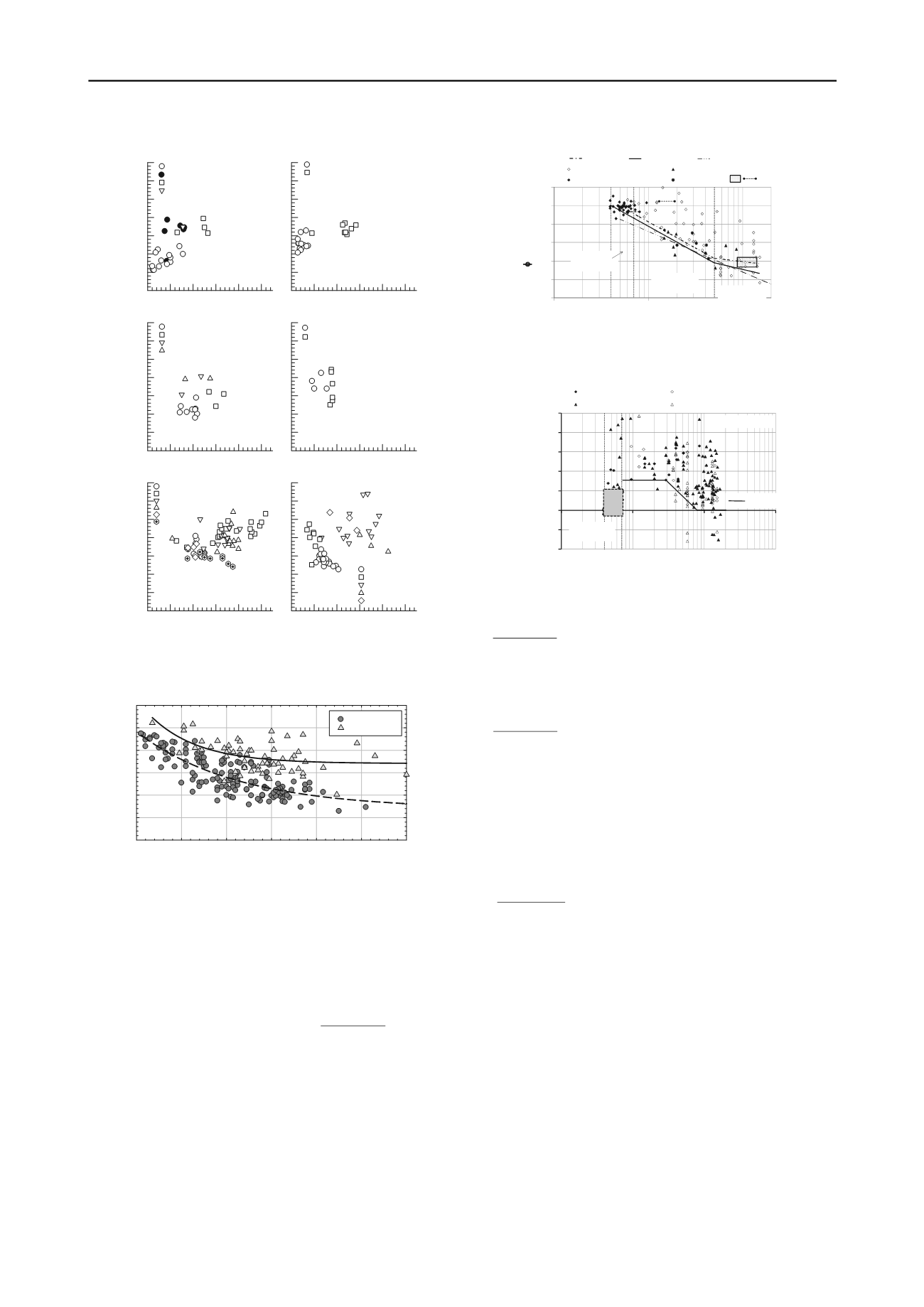
294
Proceedings of the 18
th
International Conference on Soil Mechanics and Geotechnical Engineering, Paris 2013
Plasticity index, PI (%)
0 20 40 60 80 100
K
s
= S
uE
/ S
uC
0.0
0.2
0.4
0.6
0.8
1.0
1.2
1.4
Plasticity index, PI (%)
0 20 40 60 80 100
K
s
= S
uE
/ S
uC
0.0
0.2
0.4
0.6
0.8
1.0
1.2
1.4
Plasticity index, PI (%)
0 20 40 60 80 100
0.0
0.2
0.4
0.6
0.8
1.0
1.2
1.4
Plasticity index, PI (%)
0 20 40 60 80 100
0.0
0.2
0.4
0.6
0.8
1.0
1.2
1.4
Plasticity index, PI (%)
0 20 40 60 80 100
K
s
= S
uE
/ S
uC
0.0
0.2
0.4
0.6
0.8
1.0
1.2
1.4
Plasticity index, PI (%)
0 20 40 60 80 100
0.0
0.2
0.4
0.6
0.8
1.0
1.2
1.4
(a) Scandinavian clays
(c) European and
Gulf of Mexico clays
(b) Canadian clays
(e) Japanese clays
(f) East Asian clays
(d) Middle-East clays
Iraq: Fao
Iraq: Khor Al-Zubaire
United Kingdom
France
Italy
USA: Gulf of Mexico
Korea: Namak
Thailand
Korea: Shihwa
Indonesia
Singapore
NBR site
Other sites
Norway: Definition-A
Sweden
Finland
Norway: Definition-B
Other sites
Osaka bay
Izumo
Ariake
Kinkai
Tokyo bay
Fig. 1 Anisotropic strength ratio versus plasticity index for different
depositional environments from J.Y. Won, paper 2137.
Plasticity Index (%)
0
20
40
60
80
100
120
Effective Stress Friction Angle (deg)
10
15
20
25
30
35
40
CD Direct Shear
CU Triaxial
Fig. 2 Relationship between effective stress friction angle and plasticity
index for CD direct shear tests and CU triaxial tests on undisturbed
samples from Castellanos et al., paper 2280.
natural soils can have a preferred particle orientation or
anisotropic fabric based on the deposition of the soil. The
difference was much less when remolded specimens were tested.
Empirical correlations between the index properties and the
strength and deformation properties of cohesive soils are useful
in geotechnical engineering practice. In paper 2399, Sorensen
and Okkels have suggested simple correlations between
plasticity index and drained peak strength parameters in terms
of
’
oc
and c’
oc
. The database includes triaxial compression test
results on undisturbed OC Danish clays from very low to
extremely high plasticity obtained from recent projects
including Great Belt bridge, Fehmarnbelt investigation, and
Esbjerg Harbour. The proposed correlations give cautious lower
bound values of drained strength parameters, which can be used
as a first approximation for use in the preliminary design (Fig. 3
and 4).
Fig. 3 Relationship between peak angle of shearing resistance
'
oc
and
plasticity index I
P
for overconsolidated undisturbed clays from Sorensen
et al., paper 2399.
10
15
20
25
30
35
40
1
10
100
'
oc
(deg.)
I
p
(%)
Older triaxial test (>30 yrs,n=61)
Other recent triaxial test (n=8)
GB (1992,n=38)
EB (2011,n=6)
V. low
plasticityclays
FB (2011)
Veryhigh
plasticityclays
Lowtohigh
plasticityclays
(n=8)
(n=58)
Best fitOC clays Cautious LB OC soils Cautious LBNC soils
(n=5)
‐40
‐20
0
20
40
60
80
100
1
10
100
1000
c'
oc
(kPa)
I
p
(%)
c'derived ‐ recentdata
c'derived ‐ olddata
c'estimated ‐recentdata
c'estimated ‐old data
4%<I
p
<7%clay
till(GB)
LB estimate
OCclays7%<I
P
<170%
Fig. 4. Relationship between effective cohesion c'
oc
and plasticity index
I
P
for overconsolidated undisturbed clays from Sorensen et al., paper
2399.
In paper 2639, al-Damluji et al. provided the bounding surface
plasticity model parameters for Baghdad soils by K
o
-
consolidated compression and extension triaxial undrained tests.
They mentioned these parameters can be used in the foundation
design in the central Baghdad.
In paper 2872, Likitlersuang et al. re-analysed the stress-strain
data of soft and stiff Bangkok clays carried out at Asian
Institute of Technology (AIT). Several series of isotropic
consolidated drained and undrained compression (CID, CIU)
and extension (CIUE, CIDE) tests were carried out at AIT. The
finite element software PLAXIS contains the hardening soil
model as an extension of the Duncan-Chang hyperbolic stress-
strain model. The stiffness and strength parameters required for
the hardening soil model to model undrained and drained
behaviors were obtained.
In paper 3011, Aghadam and Soroush studied mechanical
behavior of thirty types of rockfill materials based on the
hyperbolic model under triaxial compression. The rockfill
materials are categorized as three types: highly angular, angular,
and rounded. The exponent number was found to be dependent
on confining pressure due to the particle breakage. The
correlations estimating initial Young’s modulus and friction
angle were suggested based on particle shape, confining
pressure, and uniformity.
2.2.
Gas-hydrate Bearing Soil and Mining By-Products
Energy resource development is a facing problem of mankind.
Gas-hydrate is an attractive energy source but the production is
challenging due to following uncertainties such as changes in
stress condition due to pore pressure changes during phase
transition and sediment softening and volume contraction due to
loss of hydrate bonding (Lee et al., 2011). Safe and economical
storage of by-products in the coal and copper mines is an
important geotechnical problem. Three papers are in this topic
and each paper is summarized as below.


